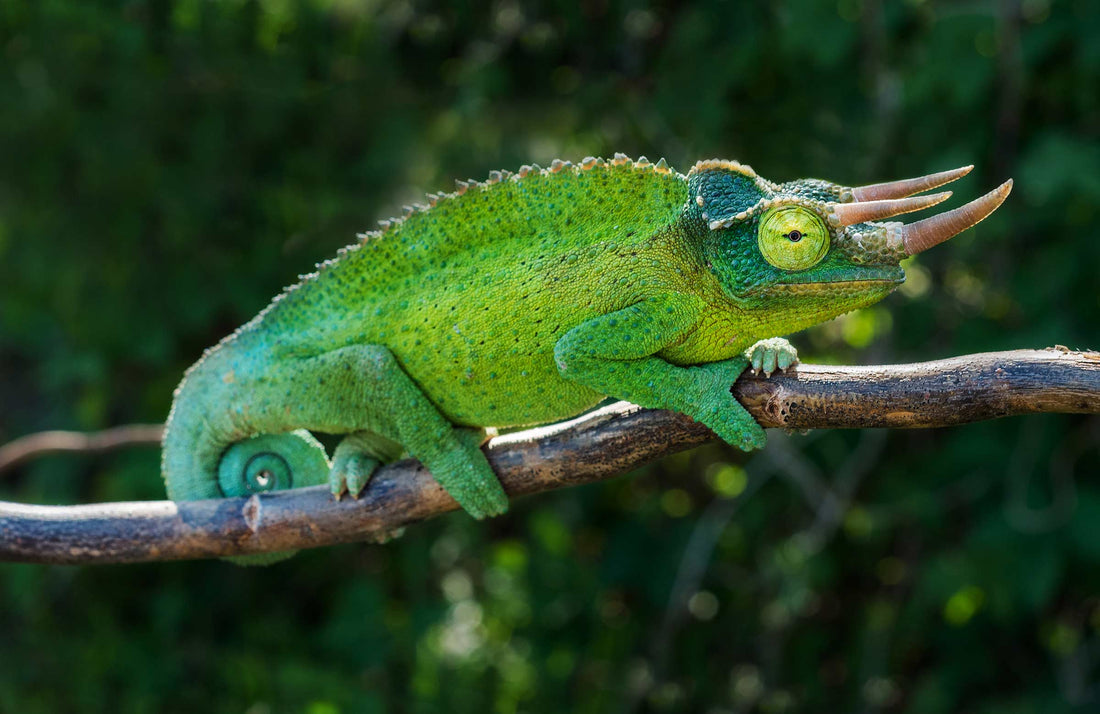Natural Habitat
Jackson's chameleons are found in the highland forests of Kenya and Tanzania in Africa. The climate in these mountain forests are fairly mild and seasonal. Luckily, their natural conditions are fairly similar to the conditions found in most of our homes and apartments. One notable exception to this is that the normal nighttime temperatures Jackson’s are adapted to are generally cooler than some homes. Jackson's chameleons are arboreal, spending most of their time above the ground in branches. Your habitat should be structured in such a way so that your chameleon has many opportunities for climbing and utilizing the entire volume of its habitat. Live plants and many branches of varying diameter should be considered a must.
Leap Habitat Size
22”x 17”x 36”
Nutrition
Jackson’s chameleons are insectivores, meaning they only eat insects. Feeding your Jackson’s chameleon as wide a variety of insect prey as possible is best. Suitable feeder insects include: crickets, mealworms, superworms, dubia roaches, fruit flies, bean beetles, blue bottle flies, and silkworms. Your feeder insects should be fed with a high quality calcium rich diet to “gutload” them and make them more nutritious for your pet gecko. Feeder insects should also be lightly dusted with a pure calcium supplement at almost every feeding. The feeders should also be dusted with a multivitamin supplement twice a month. Feed your chameleon during the day when it is active so it receives the benefits of the supplement powder before the insects remove the powder from themselves. Juveniles can be fed every day and adults three times a week. The number of insects will vary greatly depending on the type of insect and the age of your chameleon. In general feed as many insects as your chameleon will eat in ten minutes.
Five Parameters
-
Daylight/photoperiod
Jackson's chameleons are strictly diurnal, or day active. They experience some seasonal variation in lighting in their natural habitat and that should be replicated in your home. We recommend that your Leap LED lighting is on for 13 hours a day in the summer, 12 hours a day in the spring and fall, and 11 hours a day in the winter.
-
UV/photoperiod
The necessary duration of UV lighting is still being researched and UV certainly isn’t at peak levels throughout the day. At this time we recommend that the UV light is on for four to six hours a day around midday.
-
Heat
In general a “hot” side of the habitat should be provided and reach temperatures of 80-85 F. The middle of the habitat can be in the mid 70s and the “cool” side should be in the low 70s. Traditional reptile hides will not be used by chameleons but you can provide them with security by using bushy plants such as Ficus benjamina to which they can retreat to escape light and heat. A dedicated heat bulb is often not necessary for this species but if extra heat is needed a low wattage halogen bulb can be used as this is our best current technology at replicating the natural heating benefits of the sun. We recommend that your heat bulb should be on for approximately four to six hours a day around midday. Jackson’s chameleons should experience a strong night time temperature drop. A good range to aim for is 50-60 F when the lights are out.
-
Water/Misting
Jackson's chameleons will primarily drink by lapping up rain or dew droplets. They will not use a water bowl. Jackson's chameleons experience a wet and a dry season in nature. For half of the year you should use your Leap misting system for longer durations and for the other half of the year less so. It’s hard to approximate a rain schedule as everyone’s home conditions are different. In general a rain just before lights out and immediately after lights on is a good place to start. Keep in mind that even the “dry” season that a Jackson’s chameleon experiences is not that dry. They still experience regular rain during the dry season. In general, offer your chameleon the opportunity to drink at least once a day.
-
Humidity/Fogging
During the wet season Jackson's chameleons should be provided with a daytime humidity of 50-70% during the day and 80-100% at night. During the dry season a daytime humidity of 40-50% is appropriate with an increase to 70-80% at night. This can be most easily accomplished by fogging for an extended period at night but not during the day. It is important that the enclosure is allowed to dry out between fogging sessions. Prolonged periods of standing water can lead to health problems.
Handleability/Pet metric
Jackson's chameleons can be very bold and are excellent display animals but they should not be considered a pet that you will frequently handle. The only reason you should handle your chameleon is for very short weekly or biweekly physical inspections. Do not forcibly restrain your chameleon. Allow it to climb onto your hand and then place one hand in front of the other as it crawls. Keep your chameleon close to a surface like a table or the floor in case it leaves your hands. You don’t want your chameleon to fall far. Remember, even a foot off the ground is a considerable height to a small lizard. This is not an animal that should be handled by young children. Any handling done by older children should be supervised by an adult.
Difficulty
Intermediate. Due to their hardy nature and moderate size Jackson's chameleons represent a good “second chameleon”. However, they do require specialized care and are less forgiving of mistakes than other beginner reptiles.

